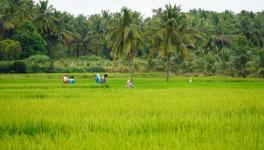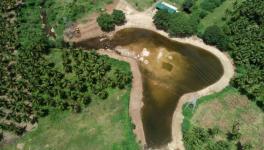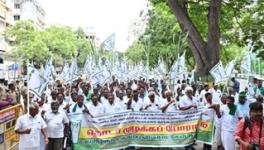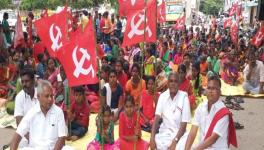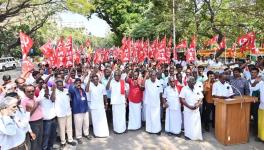TN: The Curious Case of Queuing up for Free Farm Power, Slow Subsidised Solar Transition
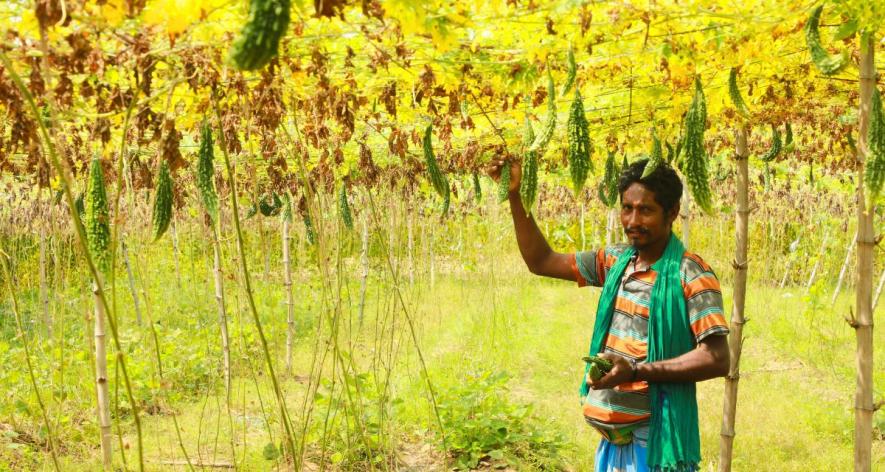
Palaniappan cultivates only vegetables as he cannot afford the water intensive crops using his present diesel pumps (Photo - Gowthami Subramaniam, 101Reporters)
Thanjavur, Tamil Nadu: Giving a gap-toothed smile, Malarkodi Subramaniam (50) of Kollangarai Vallundanpattu in Thanjavur district poses before her brand new solar panels, which to use her own words is a “divine blessing”. Up until eight months ago, she struggled operating an oil motor to water her groundnut crop on three acres of land.
“Fixing the flywheel back to the pump when it gets disconnected is quite a task. To reconnect it, I have to seek assistance from those in the nearby fields. The struggle was such that I had to make multiple trips between the field and the motor shed throughout the day to rotate the flywheel manually and operate the motor,” she recalls.
After several years of daily drudgery, relief came when she decided to get a solar pump from a private dealer. She is eligible for the free power supply that the Tamil Nadu government provides to farmers, but is unable to apply due to patta (land title) related issues. So, she had no option but to buy a solar pump worth around Rs 70,000 using her hard-earned savings. She could have applied for a subsidised solar pump under the Pradhan Mantri Kisan Urja Suraksha evam Utthaan Mahabhiyan (PM-KUSUM), but lack of awareness about the scheme posed a hurdle.
Having completed her first round of groundnut harvest profitably after the solar switch, she has decided to cultivate the crop again. “I can pump sufficient water into the fields now. Relying on a diesel motor would not have yielded such a success,” she beams.
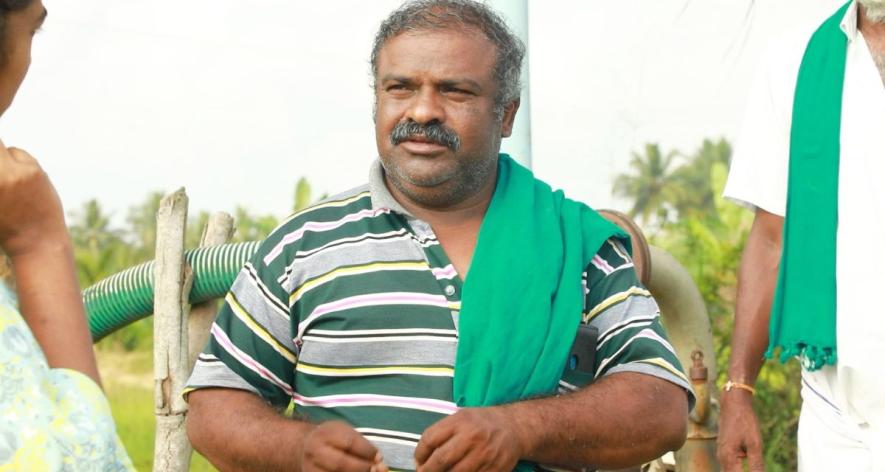
Sundar Raj is still waiting for free electricity connection since he registered in 2019 (Photo - Gowthami Subramaniam, 101Reporters)
In the same village, Panchamoorthy Veeraiyan (52) still runs a diesel motor to irrigate his 1.5-acre field. "Input cost for paddy comes to Rs 40,000, while diesel costs Rs 25,000 and motor maintenance Rs 15,000. Labour costs add up to Rs 20,000. In short, my net income after 100 days of hard work is just around Rs 20,000," he laments.
The increasing financial burden indicates the preference for free agricultural service connections. Over 23 lakh free connections have been provided so far, including one lakh connections in 2021-22 and 50,000 in 2022-23, under the scheme launched in the 1990s. Around four lakh applications are still pending. At the same time, the cost of keeping electricity free is adding up for the Tamil Nadu Generation and Distribution Corporation (TANGEDCO) and the state government. As per the 2023-24 policy note, Rs 7,857.76 crore was dedicated for free power until 2022-23.
The connections are given on a first come, first served basis, but the applicant should own at least half an acre of land with a functional well or bore well. “I cultivate only a few vegetables in my small piece of land. We lack the financial means to purchase additional land just to avail of free power,” says Palaniappan Muthaiyan (43) of Vengarayan Kudikadu.
Sundar Raj V (47) of the same village registered for agricultural service connection in 2019. “Considering the demand, I am sure it will take another five years before I receive the connection. Waiting that long for basic electricity is simply not feasible,” he says.
In such a situation, solar-powered pumps could have been a game changer. However, the pace of its uptake has been painstakingly slow in the state.
Low patronage
As per a study report, Tamil Nadu has close to 12,000 villages in 32 districts, with a majority of the districts witnessing year-round cultivation of paddy, sugarcane, maize, groundnut, etc. While some areas, particularly the catchment area of the Cauvery, are served by canal irrigation, several areas are solely dependent on rainfall and groundwater. Consequently, Tamil Nadu has an installed base of over two lakh agricultural pumps, amongst the largest in India.
Ganapathy Murugaiyan (50) lacks funds to fully utilise the abundant water resource of Vengarayan Kudikadu for a good harvest. “Currently, we can only harvest if we have the financial means to water the crops. Hence, solar pumps offer a promising solution, ensuring water availability whenever the sun shines, regardless of our financial situation,” he says.
However, Vaithiyalingam Duraikannu, chairman, Rain-fed Region Farmers Association, Thanjavur, feels that those who already have access to free electricity are unlikely to transition to solar power because they benefit from 24x7 power availability.
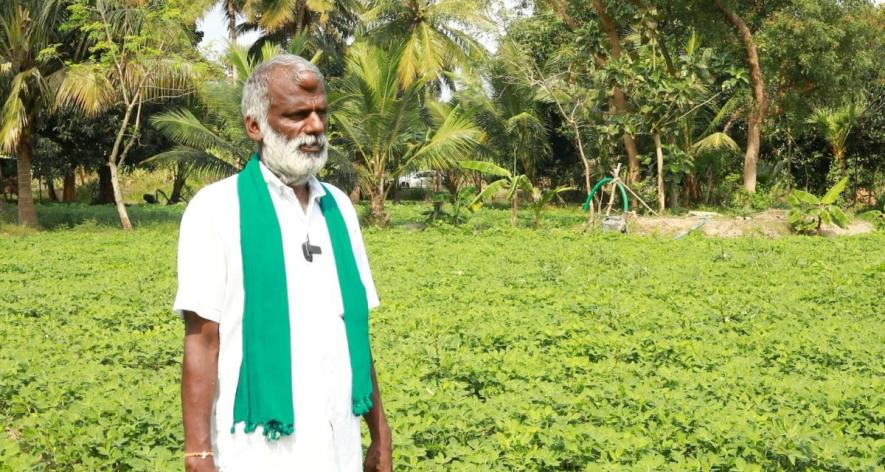
Vaithiyalingam Duraikannu calls for accessible subsidies (Photo - Gowthami Subramaniam, 101Reporters)
Though PM-KUSUM with three components seems promising, Martin Scherfler, co-founder, Auroville Consulting, tells 101Reporters that the scheme has not really taken off. “The one that has seen some numbers is PM-KUSUM’s component-B,” he claims.
Auroville Consulting collaborates with various national and international institutions and governments to develop sustainable industrial development policies and technologies.
Component-A of PM-KUSUM involves establishment of decentralised solar plants on farmlands by an individual or a group of farmers/cooperatives/panchayats/farmer producer organisations, with a capacity totalling 10,000 MW. The power generated will be purchased by a local discom at a pre-fixed tariff.
Component-B is for installing stand-alone solar agriculture pumps of up to 7.5 HP capacity by individual farmers, while component-C is for solarisation of grid-connected agriculture pumps. The farmer can sell the excess power generated under component-C to discoms at a pre-fixed tariff.
Grants of 30% each from the Ministry of New and Renewable Energy and state government would be provided under components A and C. The farmer needs to invest the remaining 40%. “For component-B, 40% subsidy comes from the Centre and 30% from the state. The remaining has to be borne by the farmers. For guidance, they may approach the Agricultural Engineering Department in their district,” informs Ramesh Desikan, Head of Department, Renewable Energy, Tamil Nadu Agriculture University.
But farmers are not impressed. “Earlier, it was mentioned that the Agriculture Department provides subsidies, but it seems unreliable. Even my friends installed solar pumps using their own funds,” claims Murugaiyan. “If we opt for the subsidy route, there is a possibility that we may not receive it immediately,” adds Veeraiyan.
Such misconceptions have reflected on the patronage of PM-KUSUM in Tamil Nadu. While the total sanctioned solar capacity in the state is 424 MW under component-A, not a single solar pump has been installed. For component-B, sanctioned capacity is 5,200 MW and installed capacity 3,187 MW. Under component-C, neither individual pump solar nor feeder level solar capacity has been sanctioned or installed.
As farmers are always in debt, Anand Prabu Pathanjali, partnerships and campaigns manager, Power for All, a global network campaigning for distributed renewable energy, insists that having less burden from another technology component like solar pump is crucial for farmers. He adds that a government push is needed for solar pump adoption, especially as the scheme is already being run since 2019 and would be available only till 2026.
Entangled in debt
One of the best outcomes of an increased patronage of PM-KUSUM in Tamil Nadu could be the opportunity to bail out TANGEDCO from its debt crisis. “TANGEDCO bears an annual cost of roughly Rs 6,000 crore to cater to the agriculture sector, one of the biggest consumers of electricity or free electricity,” says Pathanjali.
Scherfler states that the state government covers half the expenses incurred in providing free electricity, but does not always pay on time. “The remaining 50% is typically recuperated from industrial and commercial sectors through higher tariffs. However, many of these consumers have opted to generate their own renewable energy, making TANGEDCO face significant losses,” he explains.
Being a state-owned public sector undertaking, the government keeps bailing out TANGEDCO every few years. “The money for bailing out is our tax money… and we are paying even the interest on that debt,” Scherfler reminds, adding that TANGEDCO’s total outstanding debt was around Rs 1,20,000 crore last year.
Pathanjali believes that PM-KUSUM component-C has the ability to reduce dependence on agriculture service connections. Farmers will be using solar pumps for agriculture for around six months in a year. The rest of the year, they can export the produced electricity to the grid. “If money comes to farmers by exporting electricity to the grid, it would certainly improve their livelihood and rural economy in a far better way than a subsidy and free electricity,” he notes.
However, Scherfler argues that the surplus exported to the grid would most likely not be sufficient to recover the farmer’s 40% investment.
As they were not consulted while designing the scheme, farmers think that electricity meters would be introduced for component-C. “The introduction of meters is seen as a direct approach of introducing electricity tariff, which means doing away with free electricity,” says Scherfler, from his decade-long experience in energy consultancy.
Explaining further, Sundar Raj says the government has already introduced a scheme where they install a meter for electricity, allowing selling of surplus energy to the grid. “While the meter tracks energy use and production, they may purchase surplus energy initially, but may later charge us for the energy produced in our systems. So, many farmers view this scheme as unbeneficial,” he says.
Knowing well that the farmers will not be interested in solar pumps when they get free electricity, the Tamil Nadu model of PM-KUSUM component-C was designed in such a way that a developer will build a solar plant on the land rented from the farmer. For every kilowatt hour (kWh) of solar power consumed by the farmer or exported, TANGEDCO will pay Rs 3 to 4 to the developer, according to Scherfler.
Since TANGEDCO spends about Rs 9 to supply 1kWh of power to the farmer under the free electricity scheme, there is a straightaway reduction of Rs 5 if the supply is from the farmer’s land itself. “It is a viable model because it is much cheaper to produce electricity on the farm,” says Scherfler, adding that the scheme was never implemented in Tamil Nadu.
“I think there was a perception within the decision-makers that farmers would not accept it,” he says, adding that it was a political decision as farmers formed a large vote bank.
This story has been produced by the author with support from Internews’ Earth Journalism Network.
Gowthami Subramaniam is a Tamil Nadu-based freelance journalist and a member of 101Reporters, a pan-India network of grassroots reporters.
Get the latest reports & analysis with people's perspective on Protests, movements & deep analytical videos, discussions of the current affairs in your Telegram app. Subscribe to NewsClick's Telegram channel & get Real-Time updates on stories, as they get published on our website.









